Congrats are in order for Amari Williams, who has officially signed a two-way contract with the Boston Celtics after being drafted. This milestone is not just a personal achievement for Williams, but also a reflection of the careful planning and roster maneuvering that went on behind the scenes within one of the NBA’s most storied franchises. For fans who have been eagerly awaiting news of Williams’ contract status, this confirmation brings clarity and excitement, signaling Boston’s intent to integrate a promising young talent into a team with championship aspirations.
The path to a two-way contract in the NBA is never straightforward, and Williams’ journey underscores the challenges and strategic considerations that teams face during the post-draft period. A two-way contract allows a player to split time between the NBA team and its G League affiliate, providing an opportunity to develop skills while remaining connected to the parent organization. For a player like Williams, this contract not only represents financial stability but also positions him on a trajectory to compete at the highest level, with ample opportunities to prove his worth on the court. The Celtics’ decision to offer him a two-way contract indicates a belief in his potential, as well as a long-term investment in his growth as a professional athlete.
Reports indicate that the Celtics had to navigate a complex roster situation before finalizing Williams’ contract. In the modern NBA, roster spots are extremely valuable commodities, with teams balancing veteran contracts, rookie deals, and the increasingly common two-way contracts. Boston, a team consistently in playoff contention, had to ensure compliance with roster limits while maintaining flexibility for potential trades and acquisitions. The delay in signing Williams was not a reflection on his abilities, but rather a necessary step in orchestrating the team’s overall structure. It is a reminder of the intricate chess game front offices play in assembling a competitive roster, where timing and strategy often dictate contract announcements.
Williams’ signing also highlights the importance of strategic roster management for teams with championship aspirations. The Celtics have been known for their meticulous approach to team-building, often blending established veterans with emerging talent to create a dynamic and balanced roster. By securing Williams on a two-way contract, Boston can monitor his development closely, giving him exposure to NBA-level practices and game situations while also allowing for extended playing time in the G League. This dual exposure is invaluable for a young player, as it accelerates skill development, acclimatizes him to professional basketball rigor, and provides real-time feedback from coaching staff. For Williams, this is a unique opportunity to embed himself in a culture of excellence and learn from some of the best players and coaches in the league.
The Celtics’ decision to draft Williams in the first place reflects their scouting acumen and commitment to long-term player development. Draft selections are rarely arbitrary; teams invest significant resources into evaluating talent through a combination of analytics, in-person scouting, and interviews. For Williams to emerge as a draft pick, and now as a signed player, speaks volumes about his perceived potential. His skill set, athleticism, and basketball IQ likely aligned with Boston’s vision for the future, making him a valuable addition even as a two-way player. The two-way contract serves as a bridge between collegiate or amateur success and professional impact, giving Williams a platform to transition into the NBA’s demanding environment without the immediate pressure of a full-time roster spot.
It is also worth noting the broader context of Williams’ signing within the Celtics’ organizational strategy. The NBA has evolved significantly, with teams placing greater emphasis on youth development, flexibility, and cap management. Two-way contracts are an essential component of this modern strategy, allowing teams to cultivate talent while preserving cap space for key veterans or strategic acquisitions. For a team like Boston, which regularly contends in the Eastern Conference, every roster decision carries weight. Signing Williams is a calculated move, reflecting a balance between immediate competitiveness and future potential. It demonstrates that the Celtics are committed to both winning now and building sustainably for the seasons ahead.
Williams’ journey to this point has undoubtedly involved perseverance, adaptability, and dedication. The transition from college or amateur basketball to the NBA is a monumental step, often accompanied by intense scrutiny and high expectations. For many young players, the signing of a first professional contract represents the culmination of years of hard work, training, and sacrifice. Williams’ accomplishment should not be underestimated; it is a testament to his talent, resilience, and readiness to embrace the challenges of professional basketball. As he embarks on this new chapter, he has the opportunity to leverage the resources and expertise of the Celtics organization to maximize his growth and impact.
The media coverage surrounding Williams’ contract also underscores the excitement and anticipation that surrounds the NBA draft and subsequent signings. Fans are naturally curious about how new draftees will fit into existing rosters and what roles they will play. In Williams’ case, the delay in signing added an element of suspense, with speculation about the roster maneuvers that Boston might have been orchestrating. Now that the contract is official, the narrative shifts to Williams’ potential contributions on the court, his fit within the Celtics’ system, and the developmental path he will follow. This is the type of story that resonates with fans, offering both hope for future success and insight into the complexities of team management.
From a technical perspective, the two-way contract structure also provides unique opportunities and challenges for Williams. The player must adapt to varying levels of competition, different coaching styles, and fluctuating playing time. Balancing commitments between the NBA and G League requires mental resilience, physical preparation, and a commitment to continuous improvement. For Williams, this dual experience will allow him to refine his game, develop confidence, and gain exposure to high-pressure situations that are crucial for long-term success. The Celtics’ investment in him is as much about potential as it is about patience, and Williams’ response to this challenge will be closely watched by coaches, teammates, and fans alike.
In addition, Williams’ signing reflects the Celtics’ ongoing emphasis on nurturing young talent and creating a pipeline for sustained success. The organization has a history of blending experienced players with emerging prospects, fostering a culture of mentorship, collaboration, and competition. By integrating Williams into this environment, Boston is signaling its intent to maintain this developmental philosophy while staying competitive at the highest level. For Williams, the exposure to seasoned veterans, strategic coaching, and a winning culture will be instrumental in shaping his professional identity. This is an environment that values both performance and personal growth, providing him with the tools to succeed on and off the court.
The timing of Williams’ signing also illustrates the logistical considerations that teams face in finalizing roster moves. In an era where free agency, trades, and player development contracts are all intertwined, securing the right balance of talent and flexibility is critical. The Celtics’ ability to complete this process demonstrates both organizational efficiency and strategic foresight. While fans may be eager for immediate news, the behind-the-scenes work is often painstaking, requiring coordination across multiple departments, negotiation with agents, and compliance with league rules. Williams’ contract is the result of this careful orchestration, underscoring the professional rigor that characterizes successful NBA organizations.
As Williams begins his professional journey, expectations will naturally evolve. Early performance will be scrutinized, opportunities to contribute will arise, and the adjustment to the pace and physicality of the NBA will test his skills. However, the framework provided by a two-way contract is ideal for this transition, offering both challenge and support. It allows Williams to showcase his abilities, earn playing time, and gradually integrate into the Celtics’ system without the immediate pressure of full-time NBA responsibility. The organization’s investment in him reflects confidence in his potential, and it will be fascinating to observe how he capitalizes on this opportunity over the coming season.
For the Celtics, Williams’ signing is a reaffirmation of their commitment to a thoughtful, strategic approach to team-building. By managing roster spots, cap flexibility, and player development, the organization continues to position itself as a model franchise in the NBA. The integration of young talent like Williams is essential for maintaining competitive longevity, ensuring that the team remains relevant and adaptable in a constantly evolving league. It also signals to fans and other players that Boston is committed to providing opportunities for growth and advancement, further enhancing the team’s reputation as a destination for talent development.
In summary, Amari Williams’ signing of a two-way contract with the Boston Celtics represents a significant milestone for the player and a strategic move for the organization. The delay in finalizing the contract highlights the complexities of roster management and the careful planning required in the modern NBA. For Williams, this contract offers a unique opportunity to develop, compete, and embed himself within a culture of excellence. For the Celtics, it reflects a commitment to nurturing talent, maintaining roster flexibility, and positioning the team for both immediate and long-term success. Fans can now look forward to watching Williams’ progression, anticipating his contributions, and celebrating his journey as he embarks on this exciting chapter of his professional basketball career. The Celtics have once again demonstrated their ability to blend strategy, talent, and foresight, and Williams’ addition is a testament to that organizational philosophy. As the season unfolds, all eyes will be on how he leverages this opportunity, navigates the challenges of a two-way role, and integrates into one of the NBA’s most competitive and historically significant teams. With determination, skill, and the support of the Celtics’ coaching staff and veteran players, Williams has the tools to make a lasting impact and carve out a meaningful role in the league, providing fans with another reason to be excited about the future of the Boston Celtics.



